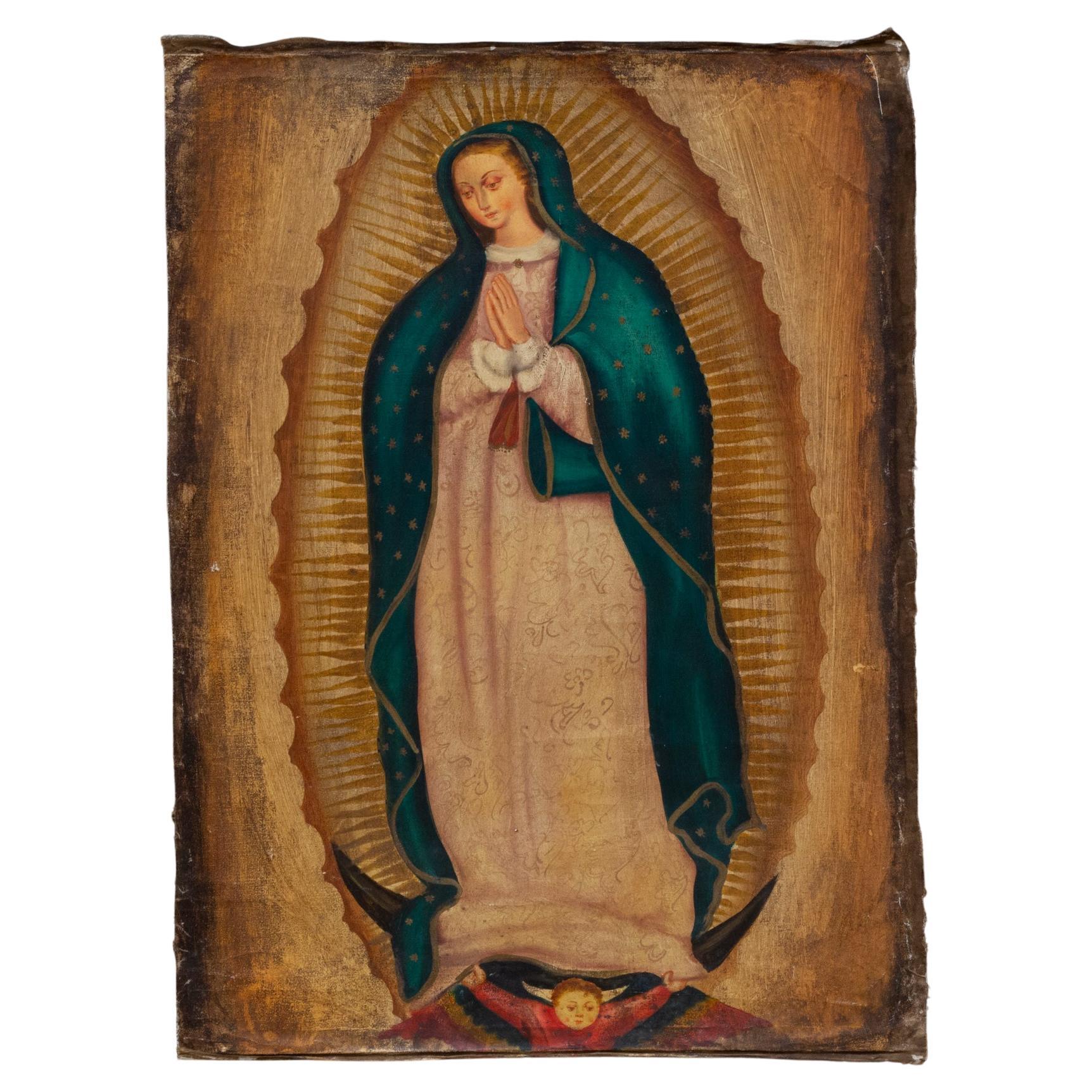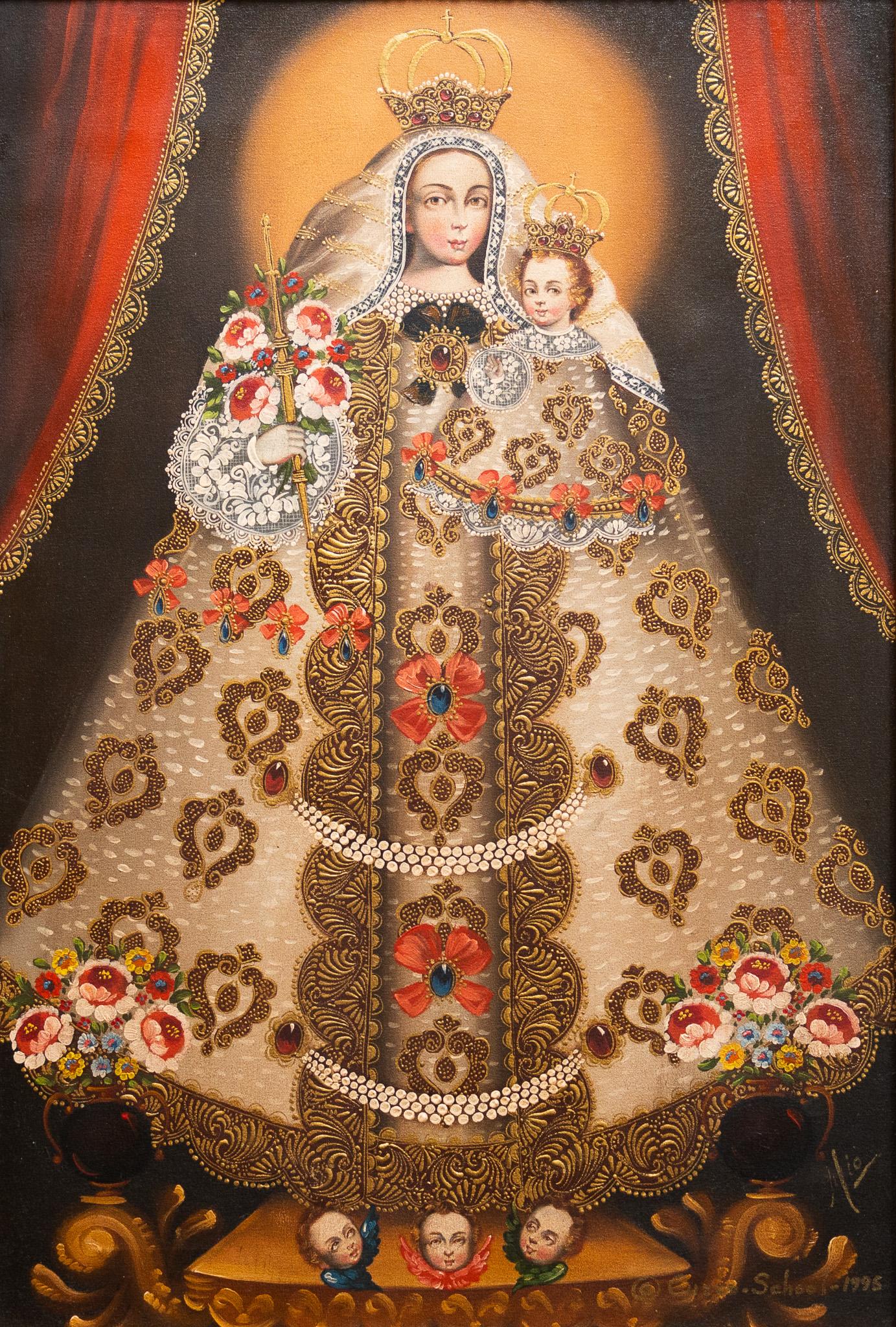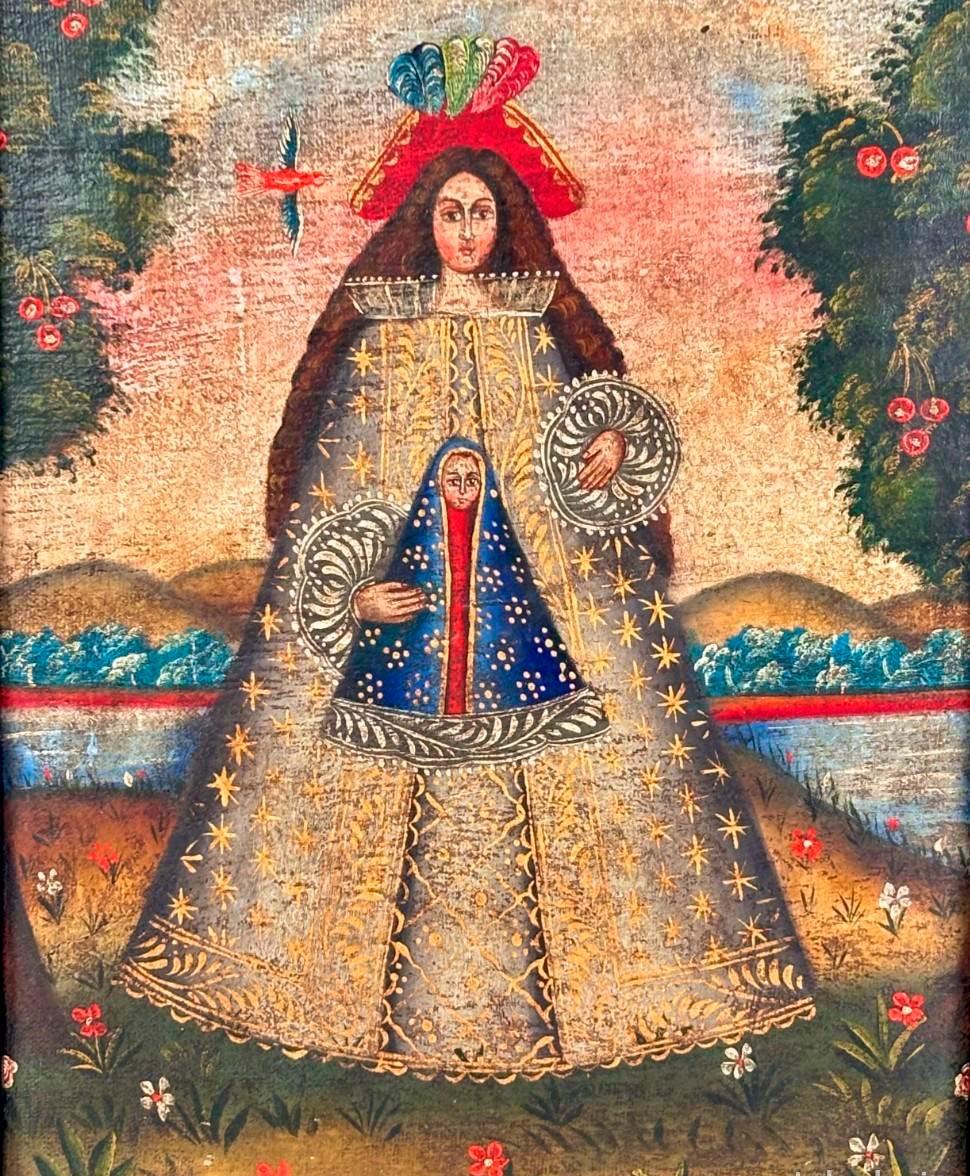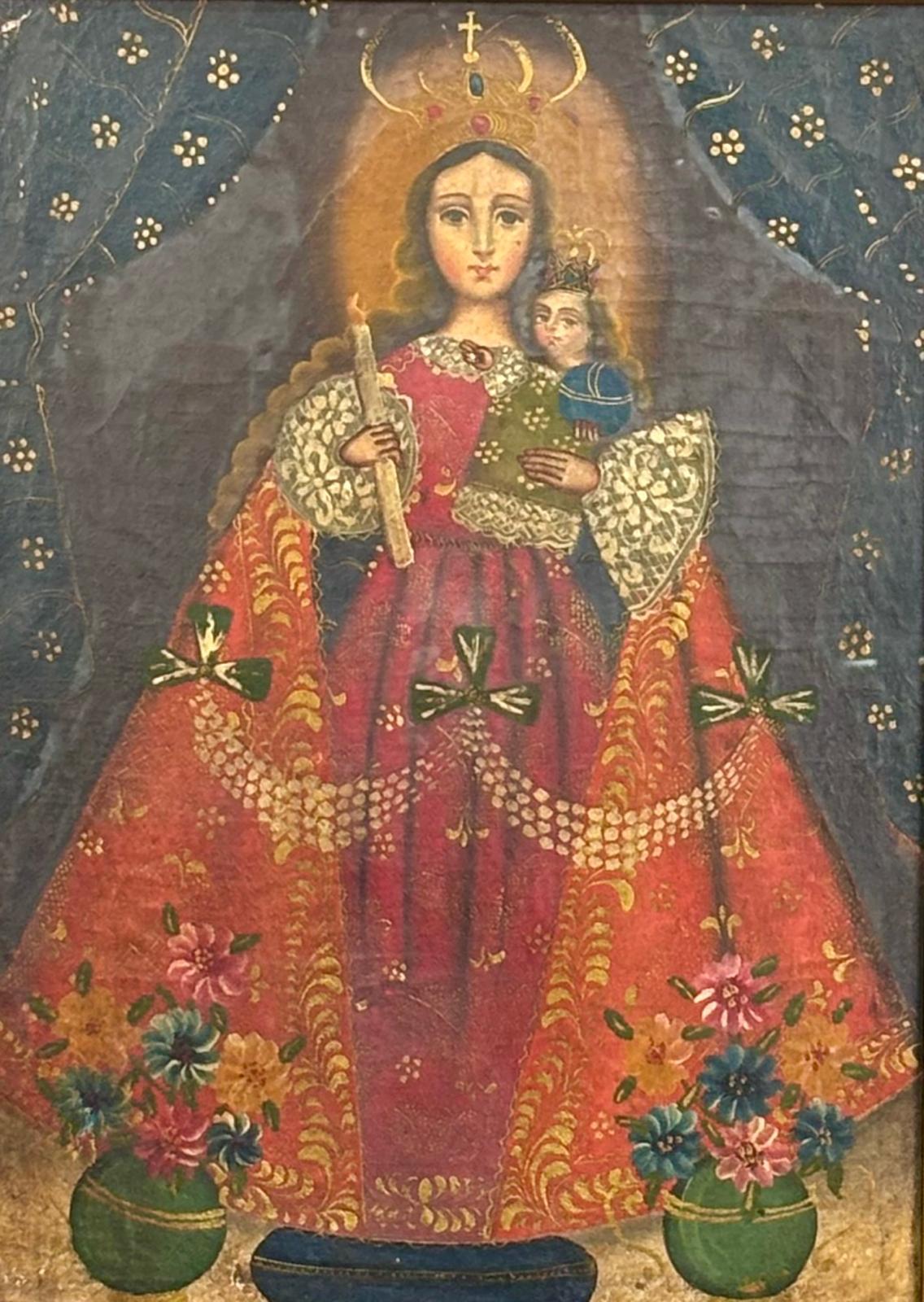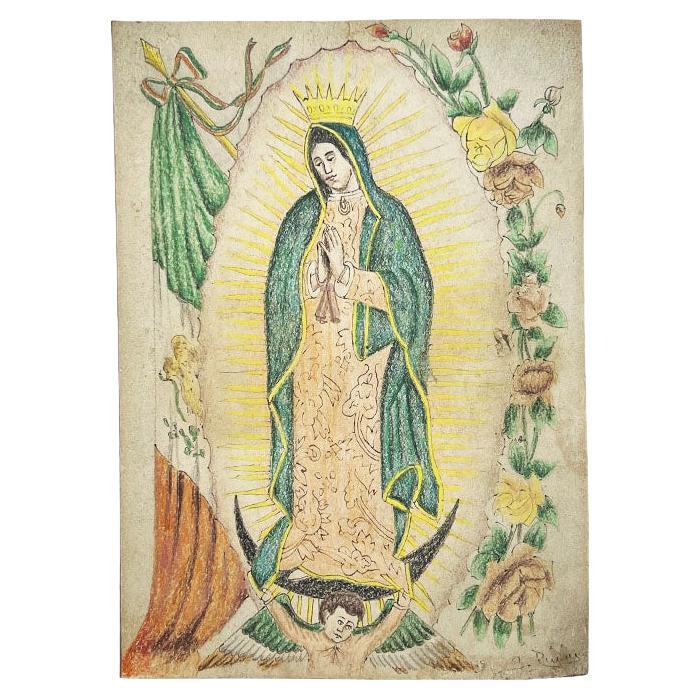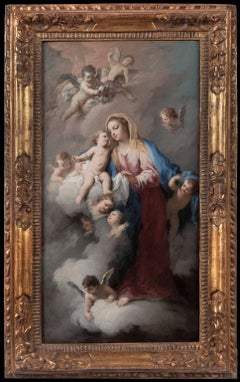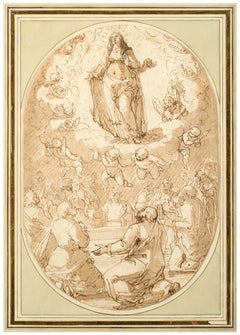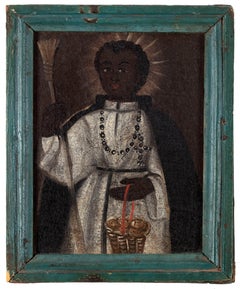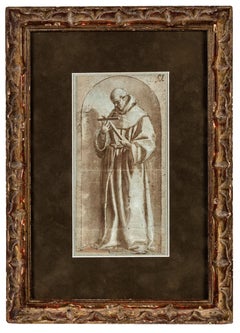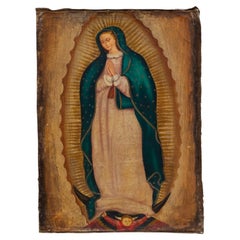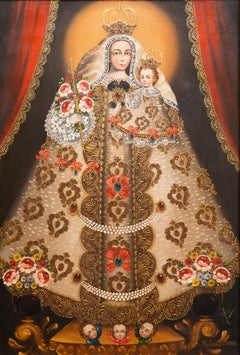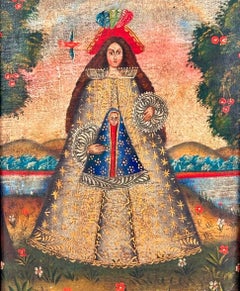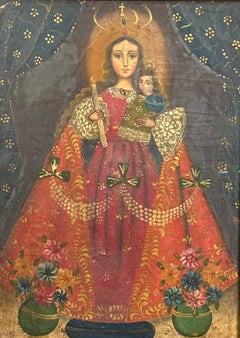Items Similar to Virgin of Guadalupe
Want more images or videos?
Request additional images or videos from the seller
1 of 2
José de la CruzVirgin of Guadalupe1788
1788
$92,000
£69,759.15
€80,552.82
CA$129,081.61
A$143,816.09
CHF 75,849.09
MX$1,743,537.82
NOK 964,909.80
SEK 898,874.59
DKK 601,655.16
About the Item
Signed and dated, lower right, Joseph de la Cruz f.t / Año de 88.
Provenance: Private Collection, Santo Stefano d’Aveto (Genoa), ca. 1960–2022.
This monumental canvas is a rare, signed example of one of the most popular subjects of Spanish Colonial, and particularly Mexican, painting: the Virgin of Guadalupe. Paintings of the Virgin of Guadalupe record the 1531 vision of Juan Diego, a Chichimec peasant and Christian convert at Guadalupe, just outside of Mexico City. According to the legend, the Virgin Mary appeared as a young dark-skinned woman to Juan Diego Cuauhtlatoatzin (his full name) and spoke to him in his native Nahuatl tongue. The cult of the Virgin of Guadalupe spread rapidly in the New World, particularly among the population of recently converted indigenous people. That the Virgin spoke in a local language and had dark skin was viewed as confirming the spiritual worthiness of indigenous Americans and underscoring the universality of Christianity. Today the Virgin of Guadalupe is venerated worldwide. Our painting is a rare signed and dated version by José de la Cruz, an artist active in Mexico in the late 18th century about whom little is known. José de la Cruz is known to have painted large-scale images of the Virgin of Guadalupe for export. Other examples by him are recorded in Seville and the Canary Islands; our painting in fact comes from the Ligurian town of Santo Stefano d’Aveto, Italy, which has long had a special devotion to the Virgin of Guadalupe.
According to the legend, in December 1531, shortly after the conquest of Mexico, Juan Diego heard a voice calling out his name while on his way to mass in a church outside Mexico City. A young dark-skinned woman appeared before him and told him that she was the mother of God and directed him to visit the bishop of Mexico, Juan de Zumárraga, to ask that a church be built in her honor on the hill of Tepeyac, the site of a former temple of the Aztec goddess Tonantzin. Juan Diego approached the bishop twice, but he required proof of this miraculous encounter. Juan Diego returned to the hill of Tepeyac and petitioned the Virgin for assistance. She reappeared and instructed him to pick the Castillian roses that were in full bloom on the hilltop (which had bloomed despite its being winter) and to return to the bishop. Juan Diego gathered the flowers in his tilmàtli—a type of native garment worn as a mantle. When Juan Diego returned to the bishop and opened his tilmàtli, he revealed the now universally recognizable standing figure of the Virgin imprinted on the fabric. This convinced the bishop of the miracle and led to the construction of a chapel on the site. The image of the Virgin that miraculously appeared on the tilmàtli, which still survives in a church on Tepeyac, served as the basis for all subsequent depictions of Virgin of Guadalupe.
The cult of the Virgin of Guadalupe became very popular among the indigenous population. Already by the mid-17th century the Virgin of Guadalupe was closely associated with Mexico and its people, and the image has remained culturally significant to the present day. In the year 1746, the Virgin was declared the patroness of the Viceroyalty of New Spain, and the image proliferated across Latin America, even making its way back to Europe as the cult of the became increasingly popular. Pope Benedict XIV approved the Office and Mass of the Virgin of Guadalupe in 1754, further cementing the legacy of the miracle and the image.
The present painting follows a standard type that stems from the original miraculous image. The Virgin appears at center on a half-moon supported by a winged putto. She stands with her proper left leg bent, as if stepping forward, and she looks downwards as she folds her hand in prayer. Her blue mantle is decorated with gold stars, and she is completely surrounded by a gold nimbus. She is surrounded by vignettes illustrating episodes from the legend of her appearance, and vines of soft-pink roses referencing those picked by Juan Diego trail up the outer edges of the painting, connecting the framed vignettes and the text corresponding to each image.
Although very little is known about José de la Cruz, it is possible to piece together some information about his career from the few documented paintings by him that have survived. In 1959, Joaquin Gonzalez Moreno recorded 5 paintings by José de la Cruz in Seville, each depicting the Virgin of Guadalupe on a large scale (measuring roughly 2 x 1 meters) and signed in a similar form to the present work. Three of these examples are dated 1788, as is our painting, while the others are undated. More recently, Patricia Barea Azcón recorded another Virgen of Guadalupe by the artist in the Cathedral of La Laguna on Tenerife (Canary Islands), signed: “Joseph de la Cruz f[eci]t / Año de [17]89.” The presence of a significant number of paintings by José de la Cruz in Seville and in the Canary Islands is a testament to the strong relationship between the Viceroyalty of New Spain and Spain itself during the Colonial period. The ports of the Canary Islands were used as a stopover point by the fleets traveling back and forth across the Atlantic. Those who ventured to New Spain evidently brought back paintings with them on their return to decorate their dwellings or donate them to religious institutions. It seems likely based on the surviving paintings by José de la Cruz that made their way to Europe, including the present painting, that the artist specialized in painting large-scale images of the Virgin of Guadalupe for export. It is no surprise that Seville, a port city from which many set sail for the New World, came to receive a significant number of paintings of the Virgin of Guadalupe by José de la Cruz. Nor is it surprising that the Virgin of Guadalupe found a significant cult following in Liguria, from which many sailors hailed.
- Creator:José de la Cruz (Mexican)
- Creation Year:1788
- Dimensions:Height: 81 in (205.74 cm)Width: 50 in (127 cm)
- Medium:
- Period:
- Condition:
- Gallery Location:New York, NY
- Reference Number:1stDibs: LU10212230162
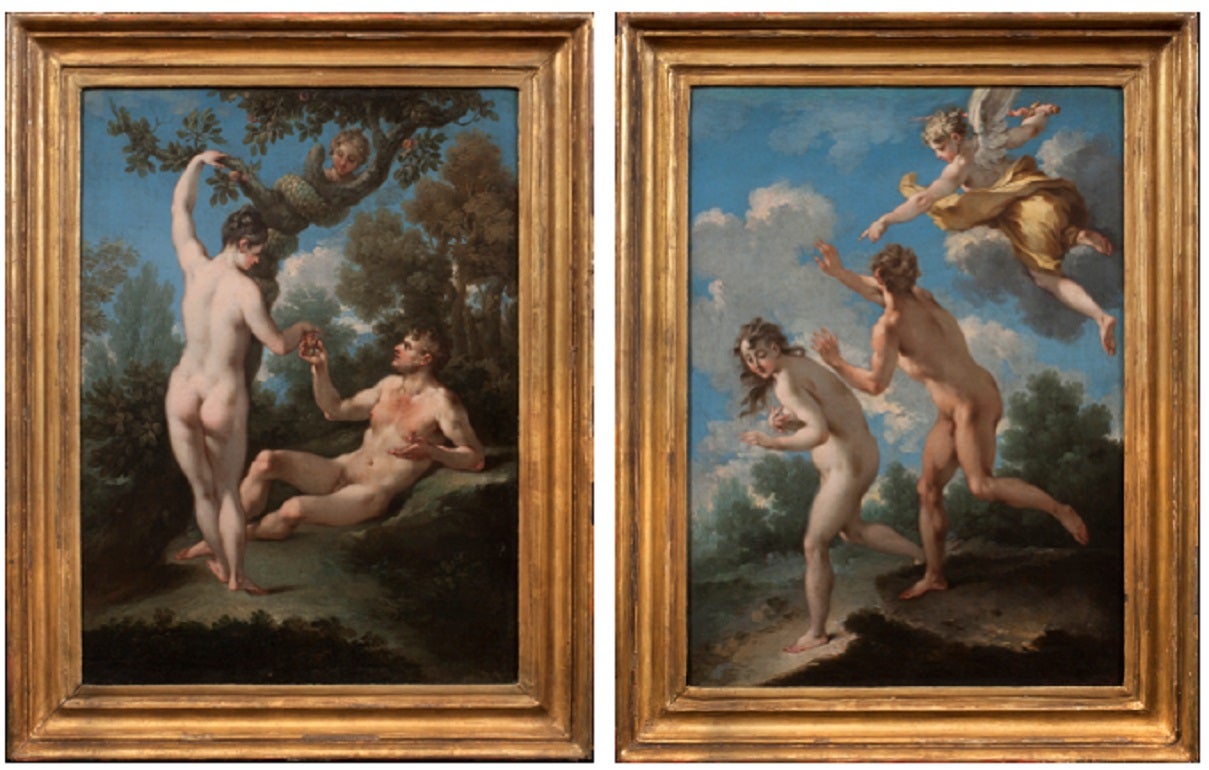
About the Seller
5.0
Recognized Seller
These prestigious sellers are industry leaders and represent the highest echelon for item quality and design.
Established in 1997
1stDibs seller since 2012
22 sales on 1stDibs
Typical response time: 5 hours
- ShippingRetrieving quote...Shipping from: New York, NY
- Return Policy
Authenticity Guarantee
In the unlikely event there’s an issue with an item’s authenticity, contact us within 1 year for a full refund. DetailsMoney-Back Guarantee
If your item is not as described, is damaged in transit, or does not arrive, contact us within 7 days for a full refund. Details24-Hour Cancellation
You have a 24-hour grace period in which to reconsider your purchase, with no questions asked.Vetted Professional Sellers
Our world-class sellers must adhere to strict standards for service and quality, maintaining the integrity of our listings.Price-Match Guarantee
If you find that a seller listed the same item for a lower price elsewhere, we’ll match it.Trusted Global Delivery
Our best-in-class carrier network provides specialized shipping options worldwide, including custom delivery.More From This Seller
View AllMadonna and Child with Angels in the Clouds
Located in New York, NY
Provenance: Charles H. and Virginia Baldwin, Claremont, Colorado Springs, Colorado ca. 1907-1934; thence by descent until sold in 1949 to:
Charles Blevins Davis, Claremont (renamed Trianon), Colorado Springs 1949 -until gifted in 1952 to:
The Poor Sisters of Saint Francis, Trianon, Colorado Springs, 1952 until acquired, 1960, by:
John W. Metzger, Trianon, renamed as the Trianon School of Fine Arts, Colorado Springs, 1960-1967; when transferred to:
The Metzger Family Foundation, Trianon Art Museum, Denver, 1967 - 2004; thence by descent in the Metzger Family until 2015
Exhibited: Trianon Art Museum, Denver (until 2004)
The present work is a spectacular jewel-like canvas by Amigoni, rich in delicate pastel colors, most likely a modello for an altarpiece either lost or never painted. In it the Madonna stands firmly upon a cloud in the heavens, her Child resting on a delicate veil further supported by a cloud, as he gently wraps his arm around his mother’s neck. From above angels prepare to lower flowers and a wreath, while other angels and seraphim surrounding the two joyfully cavort.
Dr. Annalisa Scarpa, author of the forthcoming monograph on Jacopo Amigoni...
Category
18th Century and Earlier Figurative Paintings
Materials
Canvas, Oil
The Assumption of the Virgin
Located in New York, NY
Provenance:
Unidentified collector’s mark “D.G.R,” lower right (Lugt 757b)
Wilhelm Suida (1877–1959), New York; by descent to:
Robert L. and Bertina Suida Manning, New York, until 1996
Private Collection, USA
This impressive drawing of the Assumption of the Virgin is the work of the Genoese artist Giovanni Battista Paggi. The son of a nobleman, Paggi received a humanist education and was a self-taught artist. According to Paggi’s first biographer, Raffaele Soprani, it was only after encountering Luca...
Category
16th Century Old Masters Figurative Drawings and Watercolors
Materials
Paper, Ink, Pen
Saint Martin de Porres
Located in New York, NY
Provenance: Private Collection, New York, until 2022.
Martín de Porres was born in Lima in 1579, the illegitimate son of a Spanish-American father, J...
Category
Late 18th Century Paintings
Materials
Canvas, Oil
Study of a Franciscan Saint, probably San Diego de Alcalá
Located in New York, NY
Provenance: Ivan E. Phillips, Montreal and New York, until 2023.
The brothers Bartolomé Carducho and Vicente Carducho, both born and trained in Florence, settled in Spain where they made their careers. Vicente worked on numerous commissions for both the church and the Spanish court...
Category
17th Century Old Masters Drawings and Watercolor Paintings
Materials
Paper, Chalk, Ink, Pen
The Resurrection of Christ
Located in New York, NY
Provenance:
with “Mr. Scheer,” Vienna, by July 1918; where acquired by:
Jindřich Waldes, Prague, 1918–1941; thence by descent to:
Private Collection, New York
Literature:
Rudolf Kuchynka, “České obrazy tabulové ve Waldesově obrazárně,” Památky archeologické, vol. 31 (1919), pp. 62-64, fig. 5.
Jaroslav Pešina, “K datování deskových obrazů ve Waldesově obrazárně,” Ročenka Kruhu pro Pěstování Dějin Umění: za rok (1934), pp. 131-137.
Jaroslav Pešina, Pozdně gotické deskové malířství v Čechách, Prague, 1940, pp. 150-151, 220.
Patrik Šimon, Jindřich Waldes: sběratel umění, Prague, 2001, pp. 166, 168, footnote 190.
Ivo Hlobil, “Tři gotické obrazy ze sbírky Jindřicha Waldese,” Umění, vol. 52, no. 4 (2004), p. 369.
Executed sometime in the 1380s or 1390s by a close associate of the Master of the
Třeboň Altarpiece, this impressive panel is a rare work created at the royal court in Prague and a significant re-discovery for the corpus of early Bohemian painting. It has emerged from an American collection, descendants of the celebrated Czech industrialist and collector Jindřich Waldes, who died in Havana fleeing Nazi-occupied Europe.
The distinctive visual tradition of the Bohemian school first began to take shape in the middle of the fourteenth century after Charles IV—King of Bohemia and later Holy Roman Emperor—established Prague as a major artistic center. The influx of foreign artists and the importation of significant works of art from across Europe had a profound influence on the development of a local pictorial style. Early Italian paintings, especially those by Sienese painters and Tommaso da Modena (who worked at Charles IV’s court), had a considerable impact on the first generation of Bohemian painters. Although this influence is still felt in the brilliant gold ground and the delicate tooling of the present work, the author of this painting appears to be responding more to the paintings of his predecessors in Prague than to foreign influences.
This Resurrection of Christ employs a compositional format that was popular throughout the late medieval period but was particularly pervasive in Bohemian painting. Christ is shown sitting atop a pink marble sarcophagus, stepping down onto the ground with one bare foot. He blesses the viewer with his right hand, while in his left he holds a triumphal cross with a fluttering banner, symbolizing his victory over death. Several Roman soldiers doze at the base of the tomb, except for one grotesque figure, who, beginning to wake, shields his eyes from the light and looks on with a face of bewilderment as Christ emerges from his tomb. Christ is wrapped in a striking red robe with a blue interior lining, the colors of which vary subtly in the changing light. He stands out prominently against the gold backdrop, which is interrupted only by the abstractly rendered landscape and trees on either side of him.
The soldiers’ armor is rendered in exacting detail, the cool gray of the metal contrasting with the earth tones of the outer garments. The sleeping soldier set within a jumble of armor with neither face nor hands exposed, is covered with what appears to be a shield emblazoned with two flies on a white field, somewhat resembling a cartouche (Fig. 1). This may be a heraldic device of the altarpiece’s patron or it may signify evil, referencing either the Roman soldiers or death, over both of which Christ triumphs.
This painting formed part of the collection assembled by the Czech industrialist and founder of the Waldes Koh-i-noor Company, Jindřich Waldes, in the early twentieth century. As a collector he is best remembered for establishing the Waldes Museum in Prague to house his collection of buttons (totaling nearly 70,000 items), as well as for being the primary patron of the modernist painter František Kupka. Waldes was also an avid collector of older art, and he approached his collecting activity with the goal of creating an encyclopedic collection of Czech art from the medieval period through to the then-present day. At the conclusion of two decades of collecting, his inventory counted 2331 paintings and drawings, 4764 prints, and 162 sculptures. This collection, which constituted the Waldesova Obrazárna (Waldes Picture Gallery), was first displayed in Waldes’ home in Prague at 44 Americká Street and later at his newly built Villa Marie at 12 Koperníkova Street. This Resurrection of Christ retains its frame from the Waldes Picture Gallery, including its original plaque “173 / Česky malíř z konce 14 stol.” (“Czech painter from the end of the 14th century”) and Waldes’ collection label on the reverse.
The Resurrection of Christ was one of the most significant late medieval panel...
Category
15th Century and Earlier Old Masters Paintings
Materials
Tempera, Panel
Joseph Holding the Christ Child
By Pietro Bardellino
Located in New York, NY
Provenance: Private Collection, Argentina.
A work of great delicacy and intimacy, this small painting on copper by Pietro Bardellino treats a subject which grew in popularity during the Baroque period: Saint Joseph and the Christ child...
Category
18th Century Baroque Paintings
Materials
Copper
You May Also Like
Early 20th c. Virgin of Guadalupe, Bolivia, Oil on Canvas Painting
Located in San Francisco, CA
ABOUT
Virgin of Guadalupe, unsigned, oil on canvas, unframed.
CREATOR Unsigned.
DATE OF MANUFACTURE c.1910-1940.
MATERIALS AND TECHNIQUES Oil on Canvas.
CONDITION...
Category
Early 20th Century Bolivian Spanish Colonial Paintings
Materials
Paint
"The Virgen de Huápulo" Depiction of the Virgin Mary by Martha Ochoa
By Martha Ochoa
Located in Austin, TX
By Martha Ochoa
Oil on Canvas
Canvas Size: 23.75" x 15.75"
Framed Size: 27" x 19.25"
This lovely painting by Martha Ochoa is from the Cusco tradition. The Cusco School was an artist...
Category
1990s Baroque Paintings
Materials
Oil, Canvas
VIRGEN CON NIÑO - ESCUELA CUZQUEÑA - SIGLO XIX
Located in Sant Celoni, ES
Interesante óleo sobre lienzo de Virgen con Niño de mediados del siglo XIX.
Es de escuela Cuzqueña, va con un marco ebonizádo que le queda muy bien.
En buen estado general solo tie...
Category
19th Century Paintings
Materials
Oil
Virgen con niño - óleo sobre tela.
Located in Sant Celoni, ES
Anónimo.
"Virgen con niño".
Óleo cobre tela.
Medidas obra: 55 cm. x 40 cm.
Medidas marco: 81 cm. x 66,5 cm.
Interesante oleo sobre lienzo de Virgen con Niño, es de Escuela coloni...
Category
Mid-19th Century Tribal Figurative Paintings
Materials
Oil
Virgen del Carmen
Located in Miami, FL
Colonial School, Mexico, XVIII Century
"Virgen del Carmen"
Oil on canvas
70 x 40 in
Category
18th Century Old Masters Figurative Paintings
Materials
Canvas, Oil
$8,000
Virgin of Guadalupe Hand Colored Spanish Colonial Drawing - Signed Mexico
Located in Oklahoma City, OK
This is an exquisite vintage depiction of Our Lady of Guadalupe, rendered in delicate hand-painted detail. The piece features soft, vibrant hues that highlight the iconic radiance of...
Category
20th Century Mexican Spanish Colonial Religious Items
Materials
Paper
More Ways To Browse
Aztec Painting
Antique Prayer Stand
Canary Islands
18th Century Colonial Paintings
Guadalupe Painting
18th Century Santos
18th Century Italian Religious Paintings
Aztec Gold
Christian Religious Oil Paintings
Mexican Santos Painting
17th Century Mantle
Antique Aztec
Mary Rose Young
New Mexican Santos
Virgen De
Benedict Oil Painting
Santo Stefano
Virgen Painting
